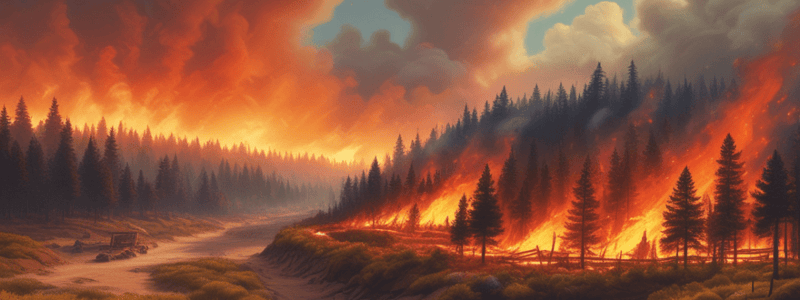Podcast
Questions and Answers
¿Cuál es una de las consecuencias principales de los incendios forestales naturales?
¿Cuál es una de las consecuencias principales de los incendios forestales naturales?
- Aumentar la disponibilidad de agua
- Causar daños a la propiedad y la vida humana (correct)
- Fortalecer los servicios de comunicación
- Mejorar la calidad del aire
¿Cuál es uno de los objetivos clave de los sistemas de alerta temprana?
¿Cuál es uno de los objetivos clave de los sistemas de alerta temprana?
- Informar a las comunidades sobre los riesgos potenciales (correct)
- Aumentar la población de ganado
- Reemplazar los servicios de atención primaria
- Reducir la cantidad de materiales peligrosos
¿Qué es crucial para reducir los impactos negativos generales de los incendios forestales?
¿Qué es crucial para reducir los impactos negativos generales de los incendios forestales?
- Aumentar la disponibilidad de suministros de socorro
- Desarrollar métodos para contener la liberación de materiales peligrosos (correct)
- Fortalecer los recursos humanos para la gestión de desastres
- Mejorar la recopilación y difusión de datos
¿Cuál es un componente esencial del proceso de recuperación después de un incendio forestal?
¿Cuál es un componente esencial del proceso de recuperación después de un incendio forestal?
¿Qué es fundamental para garantizar un enfoque coordinado para abordar los problemas causados por los incendios forestales?
¿Qué es fundamental para garantizar un enfoque coordinado para abordar los problemas causados por los incendios forestales?
¿Cuál es uno de los objetivos clave de la recopilación y análisis de información relacionada con las emergencias y los desastres?
¿Cuál es uno de los objetivos clave de la recopilación y análisis de información relacionada con las emergencias y los desastres?
¿Cuál de los siguientes factores influye en la frecuencia y severidad de los incendios forestales?
¿Cuál de los siguientes factores influye en la frecuencia y severidad de los incendios forestales?
¿Qué impacto tienen los incendios forestales en la salud de la población general?
¿Qué impacto tienen los incendios forestales en la salud de la población general?
¿Cuál es un efecto a largo plazo de los incendios forestales en la salud mental?
¿Cuál es un efecto a largo plazo de los incendios forestales en la salud mental?
¿Por qué los trabajadores de emergencia están en alto riesgo durante eventos de incendios forestales?
¿Por qué los trabajadores de emergencia están en alto riesgo durante eventos de incendios forestales?
¿Qué efecto tiene la urbanización en áreas rurales en relación con los incendios forestales?
¿Qué efecto tiene la urbanización en áreas rurales en relación con los incendios forestales?
¿Cuál es uno de los contaminantes presentes en el humo de los incendios forestales?
¿Cuál es uno de los contaminantes presentes en el humo de los incendios forestales?
Study Notes
Wildfires: Understanding Their Impact and Preventative Measures
Overview of Wildfires
Wildfires are uncontrolled fires that burn in the wildland vegetation, often in rural areas such as forests and grasslands. They are becoming increasingly prevalent worldwide, with an increase in frequency, severity, and duration. Wildfires are influenced by several factors such as drought, heat waves, and high winds, making them harder to predict and control.
Health Risks of Wildfires
Air Pollution and Smoke Exposure
Wildfire smoke consists of hazardous air pollutants, including particulate matter (PM), nitrogen dioxide (NO2), ozone, aromatic hydrocarbons, and lead. Exposure to these pollutants can lead to premature deaths in the general population. Moreover, it can exacerbate diseases of the lungs, heart, brain/nervous system, skin, gut, kidney, eyes, nose, and liver. Wildfires also have long-term effects on cognitive impairment and memory loss.
Impact on Emergency Workers
Firefighters and emergency response workers are at high risk for injuries, burns, and smoke inhalation during wildfire events, particularly when concentrations are high.
Climate Change and Wildfires
Climate change is causing warmer temperatures and drier conditions that contribute to more frequent and intense wildfires. Additionally, urbanization in rural areas often results in higher fire risks due to increased human presence near forests and grasslands. As a result, natural disasters like wildfires can disrupt transportation, communications, water supply, power and gas services, and cause significant damage to property, livestock, and human life.
Prevention and Mitigation Strategies
The following strategies can help prevent and mitigate the impact of wildfires:
-
Early Warning Systems: Implementing early warning systems and issuing health and air quality advisories can help inform communities about potential risks.
-
Containing Hazardous Materials: Developing methods to contain the release of hazardous materials during wildfires is crucial in reducing their overall negative impacts.
-
Assessing Health Needs: Assessing the health needs of the community affected by wildfires and evaluating infrastructure damage helps provide necessary support after an event.
-
Restoring Primary Care Services: Restoring primary care services, such as immunizations, child and maternal health, mental health, etc., is essential for the recovery process.
-
Strengthening Human Resources: Building stronger human resources for disaster management enables better preparedness and response efforts.
-
Data Collection and Dissemination: Collecting and analyzing information related to emergencies and disasters likely to occur in a region can help anticipate and respond effectively to wildfires.
-
Relief Supply Management: Establishing and managing stocks of relief supplies and equipment allows for efficient distribution of aid to those in need.
-
National Policies and Plans: Developing national policies, recommendations, and plans for wildfire prevention, response, and recovery helps ensure a coordinated approach to addressing issues caused by wildfires.
Studying That Suits You
Use AI to generate personalized quizzes and flashcards to suit your learning preferences.
Description
Explora la información sobre los incendios forestales, incluyendo su impacto en la salud, el cambio climático y estrategias de prevención y mitigación. Aprende sobre los peligros del humo, los riesgos para los trabajadores de emergencia, y cómo el cambio climático contribuye a la frecuencia e intensidad de los incendios forestales.




